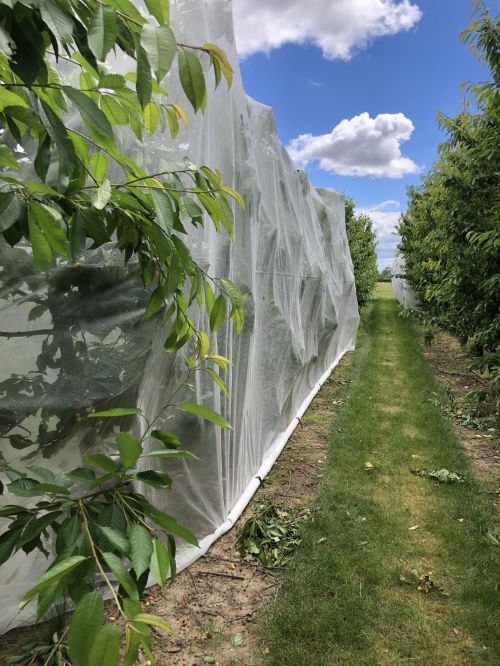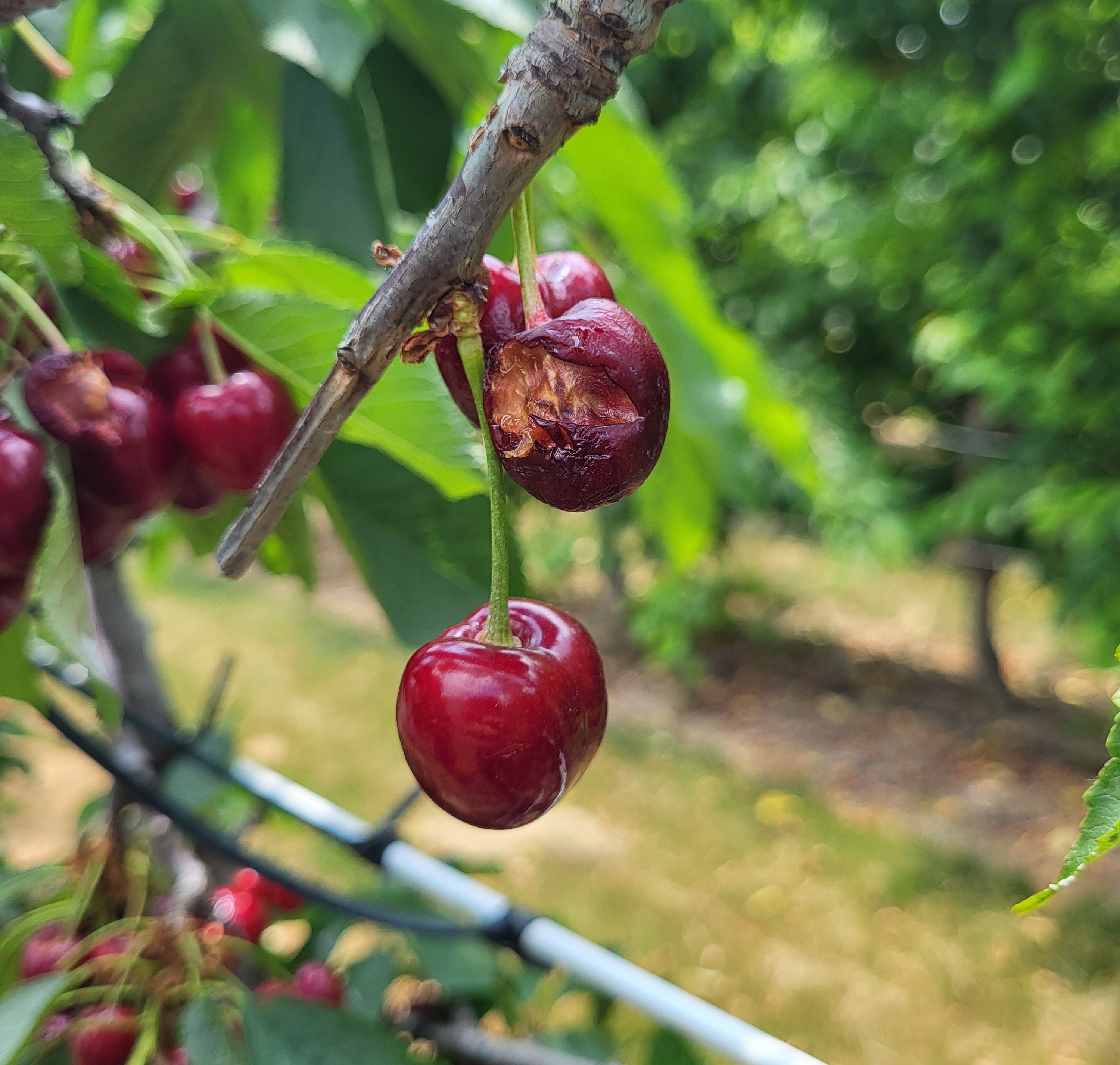Netting in high-density sweet cherries reduces bird damage and spotted wing drosophila
Over a two-year study, bird damage and SWD were reduced under nets. Netting may serve as an effective way to protect crops and reduce reliance on pesticides.

Spotted wing drosophila (SWD, Drosophila suzukii) and bird damage pose significant challenges to Michigan sweet cherry growers. The risk of SWD and bird damage vary with weather conditions (SWD risk increases in wet weather, bird damage may increase in dry weather). Netting may prevent damage from both these pests in all weather conditions and is feasible in short, high-density plantings of sweet cherries. We tested the effectiveness of netting designed to keep out insects like SWD and, consequently, birds of any size. We also assessed netting effects on fruit quality metrics and environmental conditions.
To keep up to date on SWD abundance across the state during the growing season, see reports from Michigan State University Extension.
Installing Nets
In 2023 and 2024, we conducted an experiment at the Clarksville Research Center and the Northwest Michigan Horticultural Research Center. We encased sections of high-density sweet cherry rows in netting after pollination but two to three weeks before harvest. Each net was paired with an adjacent, unnetted row of the same variety, to serve as the control.
With the help of a platform, we draped netting over the top supporting wire between posts. Since SWD are so small, the net must have no gaps to ensure insects cannot get inside the net. To seal our nets, we wrapped the bottom of the net on the ground around PVC tubing and staked it in place. The edges of the nets at the ends of rows were then rolled together and clipped with large binder clips.
Nets were kept close to the trees to allow tractor access. Insecticides and fungicides were applied on both the netted and control areas at the same time during both growing seasons.
The netting we used was called ExcludeNet and was purchased from Berry Protection Solutions. Brand names are given only as an example of what we used, and should not be considered an endorsement by Michigan State University Extension.
Pest Damage and Abundance
Bird damage: At harvest, nets were removed and cherries with bird damage were counted. When compared to unnetted controls, nets significantly reduced bird damage in 2023 and 2024.

SWD flies and larvae: Every net and control site had an SWD lure and trap that we checked once a week to track adult SWD abundance as the cherries ripened. For larval counts, cherries were collected at harvest and larvae were extracted from cherries using a brown sugar method. There were few SWD in 2023, likely due to the dryness of that growing season. In 2024, however, SWD pressure was much higher, and the netted sites had significantly reduced adult and larval SWD compared to unnetted control sites.
For more information on monitoring for SWD, see Managing Spotted Wing Drosophila in Michigan Cherry from Michigan State University.
Environment and Fruit Quality
We wanted to test whether the fine mesh of netting affected temperature and humidity. Does the net decrease the temperature for the cherries? Is humidity increased under the net? To try to address these questions, we tracked humidity and temperature with small environment monitoring devices. We found no significant differences in temperature or humidity between netted and control sites.
In addition to tracking environmental data, the following fruit quality measures were taken:
|
Quality Measure |
Effect of Netting |
|---|---|
|
Fruit Color |
No effect in either year |
|
Fruit Weight |
No effect in 2023 Higher under nets in 2024 |
|
Percent Soluble Solids |
No effect in 2023 Lower under nets in 2024 |
|
Fruit with Canker |
No effect in either year |
|
Fruit with Cracks |
Fewer under nets in 2023 No effect in 2024 |
Results showed several positive effects of netting with only one potential negative effect where the percent soluble solids metric was lower under the nets when compared to the unnetted control in one year.
Other Considerations
Our results show the promise of netting as a pest management tool in high-density sweet cherries. Nets protected the cherries from SWD and bird damage without sacrificing fruit quality. However, there are a few things to keep in mind.
Installation: Using the netting on a larger scale will likely require more innovative designs depending on the needs of the orchard operation. For example, nets need to stay sealed to be most effective against pests and should be checked regularly, especially after a windstorm. The very fine mesh of the net (0.95 mm X 0.95 mm) means it can easily be moved by wind if not secured properly. Nets may also need to be kept close to trees to allow for regular orchard maintenance such as mowing. We recommend mowing just before netting to reduce the risk of the net being ripped by frequent mowings once in place. An alternative to netting individual rows would be to cover entire blocks although this would necessitate infrastructure to support the netting and entrances to allow access for orchard management.
Spraying: Spray programs continued as normal while the nets were in place. However, we did not measure how well sprays penetrated through the netting. Netting should reduce the need for pesticides, but it is unclear how well other sprays like fungicides perform when sprayed through the net.
This work is supported by the Crop Protection and Pest Management Program [grant no 2024-70006-43569] from the USDA National Institute of Food and Agriculture. Any opinions, findings, conclusions, or recommendations expressed in this publication are those of the author(s) and do not necessarily reflect the view of the U.S. Department of Agriculture.



 Print
Print Email
Email




